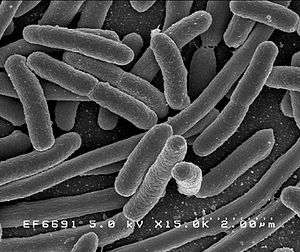MCR-1

The mobilized colistin resistance (mcr-1) gene confers plasmid-mediated resistance to colistin, one of a number of last-resort antibiotics for treating gram negative infections. mcr-1 is capable of horizontal transfer between different strains of a bacterial species and after discovery in November 2015 in E. coli (strain SHP45) from a pig in China it has been found in Escherichia coli, Salmonella enterica, Klebsiella pneumonia, Enterobacter aerogenes, and Enterobacter cloacae. As of 2017, it has been detected in more than 30 countries on 5 continents in less than a year.
Description
The "mobilized colistin resistance"(mcr-1) gene confers plasmid-mediated resistance to colistin, a polymyxin and one of a number of last-resort antibiotics for treating infections.[1][2]
mcr-1 is the first polymyxin resistance gene known to be capable of horizontal transfer between different strains of a bacterial species.[1] The gene has been found in at least five species of bacteria: Escherichia coli, Salmonella enterica, Klebsiella pneumonia, Enterobacter aerogenes, and Enterobacter cloacae.[3] It has been experimentally transferred in the lab from E. coli to Pseudomonas aeruginosa.
The mechanism of resistance of the MCR gene is a phosphatidylethanolamine transferase. The enzyme transfers a phosphoethanolamine residue to the lipid A present in the cell membrane of gram-negative bacteria. The altered lipid A has much lower affinity for colistin and related polymyxins resulting in reduced activity of the antimicrobial. This type of resistance is known as target modification.[4]
Discovery and geographical spread
The gene was first discovered in E. coli (strain SHP45) from a pig in China April 2011 and published in November 2015.[5][3] It was identified by independent researchers in human samples from Malaysia, China,[1] England,[6][7] Scotland,[8] and the United States.[9]
In April 2016, a 49-year-old woman sought medical care at a Pennsylvania clinic for UTI symptoms. PCR of an E. coli isolate cultured from her urine revealed the mcr-1 gene for the first time in the United States,[10] and the CDC sent an alert to health care facilities. In the following twelve months, four additional people were reported to have infections with mcr-1 carrying bacteria.[11]
As of February 2017 mcr-1 has been detected in more than 30 countries on 5 continents in less than a year,[12] and it appears to be spreading in hospitals in China.[13] The prevalence in five Chinese provinces between April 2011 and November 2014 was 15% in raw meat samples and 21% in food animals during 2011–14, and 1% in people hospitalized with infection.[1]
See also
References
- 1 2 3 4 Liu, YY; Wang, Y; Walsh, TR; et al. (18 November 2015). "Emergence of plasmid-mediated colistin resistance mechanism MCR-1 in animals and human beings in China: a microbiological and molecular biological study.". Lancet Infect Dis. 16: 161–8. PMID 26603172. doi:10.1016/S1473-3099(15)00424-7.
- ↑ Reardon, Sara (21 December 2015). "Spread of antibiotic-resistance gene does not spell bacterial apocalypse — yet". Nature. doi:10.1038/nature.2015.19037.
- 1 2 Gao, Rongsui; Hu, Yongfei; Li, Zhencui; et al. (28 November 2016). "Dissemination and Mechanism for the MCR-1 Colistin Resistance". PLOS Pathogens. 12 (11): e1005957. PMC 5125707
 . PMID 27893854. doi:10.1371/journal.ppat.1005957.
. PMID 27893854. doi:10.1371/journal.ppat.1005957. - ↑ Hinchliffe, Philip; et al. (2017). "Insights into the Mechanistic Basis of Plasmid-Mediated Colistin Resistance from Crystal Structures of the Catalytic Domain of MCR-1". Scientific Reports doi:. 7: 39392. doi:10.1038/srep39392.
- ↑ "Newly Reported Gene, mcr-1, Threatens Last-Resort Antibiotics". Antibiotic/Antimicrobial Resistance: AR Solutions in Action. Centers for Disease Control and Prevention. 30 November 2016.
- ↑ Schnirring, Lisa (18 December 2015). "More MCR-1 findings lead to calls to ban ag use of colistin". CIDRAP News. CIDRAP — Center for Infectious Disease Research and Policy. Retrieved 2015-12-22.
- ↑ McKenna, Maryn. "Apocalypse Pig Redux: Last-Resort Resistance in Europe". Phenomena. Retrieved 28 May 2016.
- ↑ "Antibiotic-resistant bacteria detected in Scotland". BBC News. 2016-08-03. Retrieved 2017-03-29.
- ↑ The U.S. Military HIV Research Program (MHRP). "First discovery in United States of colistin resistance in a human E. coli infection". ScienceDaily. Retrieved 2016-05-27.
- ↑ Wappes, Jim (26 May 2016). "Highly resistant MCR-1 'superbug' found in US for first time". CIDRAP News. CIDRAP — Center for Infectious Disease Research and Policy. Retrieved 2016-08-09.
- ↑ "Tracking mcr-1". Antibiotic/Antimicrobial Resistance: Biggest Threats. Centers for Disease Control and Prevention. 24 February 2017.
- ↑ Yi, L; Wang, J; Gao, Y; et al. (February 2017). "mcr-1-Harboring Salmonella enterica Serovar Typhimurium Sequence Type 34 in Pigs, China.". Emerging Infectious Diseases. 23 (2): 291–5. PMC 5324782
 . PMID 28098547. doi:10.3201/eid2302.161543.
. PMID 28098547. doi:10.3201/eid2302.161543. - ↑ Dall, Chris (27 January 2017). "Studies show spread of MCR-1 gene in China". CIDRAP News. CIDRAP — Center for Infectious Disease Research and Policy.